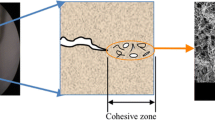Abstract
Finite element simulations of dynamic fracture problems usually require very fine discretizations in the vicinity of the propagating stress waves and advancing crack fronts, while coarser meshes can be used in the remainder of the domain. This need for a constantly evolving discretization poses several challenges, especially when the simulation is performed on a parallel computing platform. To address this issue, we present a parallel computational framework developed specifically for unstructured meshes. This framework allows dynamic adaptive refinement and coarsening of finite element meshes and also performs load balancing between processors. We demonstrate the capability of this framework, called ParFUM, using two-dimensional structural dynamic problems involving the propagation of elastodynamic waves and the spontaneous initiation and propagation of cracks through a domain discretized with triangular finite elements.























Similar content being viewed by others
References
Gao H, Klein P (1998) Numerical simulation of crack growth in an isotropic solid with randomized internal cohesive bonds. J Mech Phys Solids 46:187–218
Klein P, Gao H (1998) Crack nucleation and growth as strain localization in a virtual-bond continuum. Eng Fract Mech 61:21–48
Camacho GT, Ortiz M (1996) Computational modelling of impact damage in brittle materials. Int J Solids Struct 33:2899–2938
Needleman A (1997) Numerical modeling of crack growth under dynamic loading conditions. Comput Mech 19:463–469
Geubelle PH, Baylor JS (1998) Impact-induced delamination of composites: a 2D simulation. Compos Part B 29B:589–602
Johnson E (1992) Process regions changes for rapidly propagating cracks. Int J Fract 55:47–63
Diaz AR, Kicuchi N, Taylor JE (1983) A method of grid optimization for finite element methods. Comput Methods Appl Mech Eng 41:29–45
Zienkiewicz OC, Zhu JZ (1987) A simple error estimator and adaptive procedure for practical engineering analysis. Int J Numer Methods Eng 24:333–357
Ortiz M, Quigley IV JJ (1991) Adaptive mesh refinement in strain localization problems. Comput Methods Appl Mech Eng 90:781–804
Camacho GT, Ortiz M (1997) Adaptive Lagrangian modelling of ballistic penetration of metallic targets. Comput Methods Appl Mech Eng 142:269–301
Lawlor O, Chakravorty S, Wilmarth T, Choudhury N, Dooley I, Zheng G, Kalé L (2006) Parfum: a parallel framework for unstructured meshes for scalable dynamic physics applications. Eng Comput 22(3–4):215–235
Kalé LV, Krishnan S (1996) Charm++: parallel programming with message-driven objects. In: Wilson GV, Lu P (eds) Parallel programming using C++. MIT Press, Cambridge, pp 175–213
Edwards HC, Stewart JR (2001) Sierra, a software environment for developing complex multiphysics applications. In: Bathe KJ (ed) Computational fluid and solid mechanics. Proceedings of the first MIT conference, Oxford, UK. Elsevier, Cambridge, pp 1147–1150
Ollivier-Gooch C, Chand K, Dahlgren T, Diachin LF, Fix B, Kraftcheck J, Li X, Seol ES, Shephard M, Tautges T, Trease H (2006) The tstt mesh interface. In: 44th AIAA aerospace sciences meeting and exhibit, vol 529
Huang C, Lawlor O, Kalé LV (2003) Adaptive MPI. In: Proceedings of the 16th international workshop on languages and compilers for parallel computing (LCPC 03), College Station, TX, pp 306–322
Kalé LV (2002) The virtualization model of parallel programming: runtime optimizations and the state of art. In: LACSI 2002, Albuquerque
Huang C, Zheng G, Kumar S, Kalé LV (2005) Performance evaluation of adaptive MPI. In: PPL technical report 05-04
Karypis G, Kumar V (1997) A coarse-grain parallel formulation of multilevel k-way graph partitioning algorithm. In: Proceedings of the 8th SIAM conference on parallel processing for scientific computing
Rivara MC (1997) New longest-edge algorithms for the refinement and/or improvement of unstructured triangulations. Int J Numer Methods Eng 40:3313–3324
DeCougny HL, Shephard MS (1999) Parallel refinement and coarsening of tetrahedral meshes. Int J Numer Methods Eng 46(7):1101–1125
Lew A, Radovitzky R, Ortiz M (2001) An artificial-viscosity method for the Lagrangian analysis of shocks in solids with strength on unstructured, arbitrary-order tetrahedral meshes. J Comput Aided Mater Design 8:213–231
Benson DJ (1992) Computational methods in Lagrangian and eulerian hydrocodes. Comput Methods Appl Mech Eng 99:235–394
Cook RD, Malkus DS, Plesha ME (1989) Concepts and applications of finite element analysis, 5th edn. Wiley, London
Ju JW (1989) On energy-based coupled elastoplastic damage theories: constitutive modeling and computational aspects. Int J Solids Struct 25:803–833
Zheng G, Lawlor OS, Kalé LV (2006) Multiple flows of control in migratable parallel programs. In: 2006 international conference on parallel processing workshops (IC PPW’06). IEEE Computer Society, Columbus, OH, pp 435–444
Zheng G (2005) Achieving high performance on extremely large parallel machines: performance prediction and load balancing. Ph.D. thesis, Department of Computer Science, University of Illinois at Urbana-Champaign
Bhandarkar M, Kale LV, de Sturler E, Hoeflinger J (2001) Object-based adaptive load balancing for MPI programs. In: Proceedings of the international conference on computational science, San Francisco, CA. LNCS 2074, pp 108–117
Antoniu G, Bouge L, Namyst R (1999) An efficient and transparent thread migration scheme in the PM 2 runtime system. In: Proceedings of the 3rd workshop on runtime systems for parallel programming (RTSPP) San Juan, Puerto Rico. LNCS 1586. Springer, Heidelberg, pp 496–510
Acknowledgments
The authors gratefully acknowledge the support of NSF through grant EIA 01-03645 and of the Center for the Simulation of Advanced Rockets under contract number B341494 by the US Department of Energy.
Author information
Authors and Affiliations
Corresponding author
About this article
Cite this article
Mangala, S., Wilmarth, T., Chakravorty, S. et al. Parallel adaptive simulations of dynamic fracture events. Engineering with Computers 24, 341–358 (2008). https://doi.org/10.1007/s00366-007-0082-x
Received:
Accepted:
Published:
Issue Date:
DOI: https://doi.org/10.1007/s00366-007-0082-x




